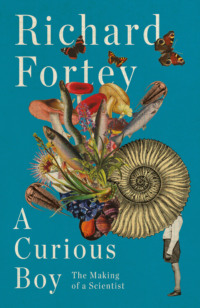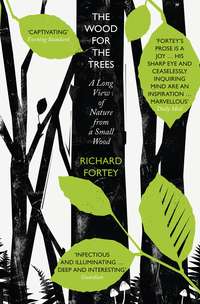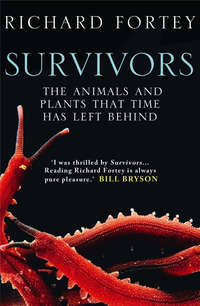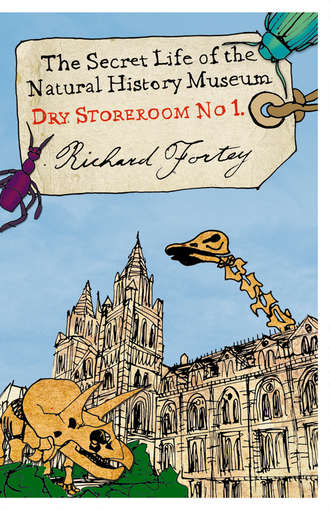
Полная версия
Dry Store Room No. 1: The Secret Life of the Natural History Museum
The new species is almost ready to go to publication, but before it can be a valid addition to biodiversity some other important criteria have to be fulfilled. A specimen from the collection has to be selected as the ‘type specimen’; this is a unique specimen upon which the identity of the new species must ultimately rest. It is known technically as the holotype in animal taxonomy, and to be valid must be given an official museum number unique to it. Other specimens in the original collection identified by the author are paratypes. Together, these specimens constitute the type collection – the material that provides the material basis for a species’ identity in perpetuity: serious stuff. The type specimens are the scientific treasures behind the scenes of the Natural History Museum, a register of biodiversity, held for future generations. They are the ground truth for species in the natural world. Scientists who wish to know whether they are really dealing with the same species will, in the end, have to refer to the types for a definitive opinion. Is this weed that has suddenly taken over crop fields in South America a European invader? Is this fossil ammonite the same as one described in the early nineteenth century from Dorset – and hence are the rocks from which it came likely to be the same age? Is this fly that is plaguing cattle in Namibia the same as one from Libya, and if so how did it get there? Ultimately, the resolution of such questions means that the original specimens have to be examined. Once again, the web is making some difference to how this works out in practice, since it is possible to visit collections in virtual reality. But many fine details – like tiny hairs and microscopic characters – will probably never be accessible over the web. Then there are the sheer numbers involved. A recent estimate puts the London museums’ holdings of types at about 670,000; it would be a vast undertaking to put them all online. Originally, the Natural History Museum hung on to its types as firmly as the original BM hangs on to the Elgin Marbles. But now in more enlightened times type specimens can travel to recognized sister institutions and bona fide workers. And of course the latter are always welcome as visitors to the vaults. This process probably helps more than anything else in recognizing synonyms, and improving the global standard of taxonomy. So the spoils of Empire have now become a global resource, one that should be recognized by all international bodies concerned with biodiversity.
Scientists deposit their type specimens in the Natural History Museum, or its equivalents elsewhere in the world, because they know that the specimens have been properly curated and cared for there, and should be looked after for future generations. Hence the collection builds steadily in importance as a reference base. There are plenty of examples elsewhere where type specimens have not been recognized for what they were. There are universities that have supported a well-known scholar, and when he or she dies the collections made by the scientist have been assigned to a dusty corner and forgotten. I know of an example where type specimens of fossil ammonites have been rescued from a skip; they might have finished up in the foundations of a building rather than as the foundation of a species. Some type specimens are historically celebrated. The duck-billed platypus (Ornithorhynchos) is a bizarre Australian mammal, which is famous for laying eggs and having mouthparts like a shoveller duck, not to mention a tail like a beaver. When a specimen was brought to Europe in 1798 it was thought to be a fake, a confection stitched together from different animals by a taxidermist with a perverse or mischievous sense of humour, for it was an animal that should by rights not exist in a well-ordered world. A careful description of the type material proved that the antipodean puzzle really was what it purported to be. We are now quite familiar with its living reality thanks to wildlife photography of the platypus in its natural habitat, where it uses that curious bill to sense small animals on stream bottoms, and the tail to help it swim – not so much an unnatural impossibility as a highly evolved specialist that retains some ancient characteristics. But the type specimen still resides in the collections of the Natural History Museum as a slightly scruffy skin, a veteran of the triumph of science over disbelief. Most types are altogether less famous, and much less conspicuous. Holotypes in the Palaeontology Department are marked only by a modest green spot attached to the rock. Their presence is known only to a small number of specialists and curators. But their importance will not diminish as long as our species pays any attention at all to fellow inhabitants of our planet. The types are still only a small part of the collections; the rest includes comparative material of many more species, or collections made from inaccessible parts of the world, or collections associated with a distinguished individual; so many riches contribute to the archive of the natural world.

The type specimen of the duck-billed platypus (Ornithorhynchus anatinus). This animal was not believed to be real when it was first described.
Duck-billed platypus. Photo © Natural History Museum, London.
The taxonomic process as I have described it would certainly have applied at the time I first nosed my way cautiously around the maze of offices and corridors in the Natural History Museum. I still believe today in the primacy of collections and specimens – they don’t go out of fashion, because they are preserved to outlive any passing phase of epistemology. However, it would be surprising if there had not been changes in scientific practice and theory over the last decades, if only because science always moves on. I deliberately concentrated on species above, because that basic unit has retained its central role in systematics, no matter how technique and theory have changed elsewhere. Species are not merely specious.
The most important change in the scientific firmament was the appearance of molecular techniques. The possibility of sequencing genes followed upon the unravelling of the structure of DNA – and now has reached new heights after the decoding of entire genomes, including that of our own species. What began as a major technical challenge is now almost entirely routine, and every research institute worth its salt, including the Natural History Museum, has a molecular biology laboratory, staffed by scientists of the white-coated variety, slaving away with test tubes in front of highly sterile machines. Nowadays, an organism must reveal its secrets down to the molecules in its DNA or RNA. Gene sequences provide a whole plethora of characters to add to the traditional morphology – something to challenge the hairs on legs, spines on shells, pattern of bones or structure of flowers. Because the genome is almost unimaginably huge, the potential for information locked in its sequences of bases is theoretically almost endless. It is small wonder that there has been a boom in the employment of molecular biologists at the expense of traditional experts on groups of organisms.
More than twenty years on from the appearance of these techniques it is possible to see just how many questions can now be tackled which were previously beyond reach. Many people have used the obvious pun ‘designer genes’ before, but it is not a bad phrase to summarize what scientists actually do with the vastness of the genome. They use different parts of it for different purposes. If they have been curated appropriately, pieces of type specimens can even be fed into the DNA factory, thanks to a technique known as PCR that ‘magnifies’ sequence information from tiny pieces of tissue. There is, of course, much variation in the genome within a species. Some variation is at the level of the individual – hence the possibility of ‘nailing’ a criminal for an offence using stored samples such as blood or semen years after a deed has been committed. The gene sequences in question identify a particular person beyond doubt, like a fingerprint. Other changes in gene sequences are conserved for slightly longer periods of time; sections of DNA called microsatellites have high rates of mutation, which makes them ideal for studies within the historical time span and within species – for example, in tracing movements of human populations around the world. Other parts of the genome change still more slowly, and yield sequences that are of particular use in recognizing species – we will come back to these again, because they are of special importance in taxonomy. Other parts of the genome are generally conserved, which means they accumulate changes only very slowly, over millions of years, or even longer. Some of these genes are important in the functioning of any organism – they include genes that encode proteins, for example. Or there is the RNA of the cell’s ‘powerhouse’ organelle, the mitochondrion, which was one of the first molecules of this kind to be completely sequenced. Such slowly changing genes and sequences allow the scientist to ‘see’ backwards in time to the divergence of major lines of evolution, to examine relationships between different groups of organisms that might previously only have been investigated by the palaeontologist delving deep in the fossil record. To say that these discoveries had a profound effect on systematics would be a considerable understatement: it provided a whole new way of looking at the natural world. There are even genes that could potentially ‘see’ the separation of the major designs of animals and plants hundreds – even thousands – of millions of years ago. In 1991 great surprise greeted the discovery that the sequence of the elongation factor gene in the nematode worm Coenorhabditis elegans was more than 80 per cent similar to that in a mammal; here was common ancestry writ large. Some genes were evidently so deep-seated that they continued to do their work over a timescale of many, many millions of years. Such evidence proved beyond question that we are one with the worm and the bacterium.
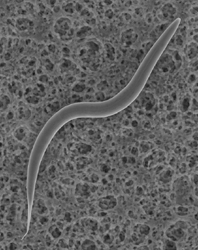
The small nematode ‘worm’ Coenorhabditis elegans – so important in working out the genetics of all animals
Nematode worm. Coenorhabditis elegams. Photo © Phototake Inc./ Alamy.
Evidence from molecules was quite quickly incorporated into the intellectual armoury of the more forward-thinking systematists. For a while there was resistance in some quarters by experts who trusted implicitly their traditional characteristics for classification – colour, or hairs on legs, or behavioural patterns – and did not like the suggestions of new evolutionary relationships thrown up by molecular studies; and it was also true that in the early days some dubious conclusions were drawn from using the wrong ‘designer gene’ for a particular job. However, it was soon recognized that sequencing evidence could provide answers to questions that had been troubling systematists for years. I will give just one example. Edible truffles are subterranean fungi, belonging to the genus Tuber. There are several species, and gourmets dispute their relative merits. Tuber magnatum, the white truffle, which grows in Italy, commands the highest prices – up to about $5,000 a kilogram. It is the most expensive foodstuff in the world. The Périgord truffle, T. melanospermum, is mostly French in origin, and black rather than white. The warty summer truffle, T. aestivum, grows in England, but is less sought after, although it is the only one I have found in the wild. All are remarkable for having an extraordinary, and some would say irresistible, odour, which suggests a kind of mushroom/meat hybrid. This intense fragrance is imparted to oil or eggs, and indeed the simplest way to eat truffles is to use them to flavour an omelette, or to grate them finely over scrambled eggs. Pâté defois truffé is such stuff as gourmet dreams are made of. The edible properties of the truffle are not matched by their aesthetic ones, for most truffles look like some kind of knobbly animal excreta, which have been passed with not a little discomfort. They do not have to impress with their appearance, for it is the smell that matters. In the wild they grow close to the roots of trees, particularly oak (Quercus) and hazel (Corylus); they are one of a very large number of fungi that form a symbiotic relationship with the tree host, their mycelium enveloping or penetrating the roots in a so-called mycorrhiza. The host benefits from ions such as phosphate that the fungus can ‘hunt’ from the surrounding soil, while the fungus receives products of photosynthesis from its tree host in return. The problem for the fungus is how to spread its spores from underground and hence ensure its survival, and this is where the smell comes in. The spores are enclosed in chambers or fissures inside the truffle. Animals such as wild pigs find the smell of the truffle attractive, and will greedily grub up the fruit bodies. ‘Truffle pigs’ are trained to smell out the subterranean booty, which is removed from them before they can gobble it up. The spores will eventually pass out of the animal, unharmed, in droppings, having by then been dispersed widely from their point of origin. In rainforests in south-eastern Australia I have seen holes scratched by marsupial potoroos in search of truffles – very different creatures performing the same favour for a truffle on the other side of the world.
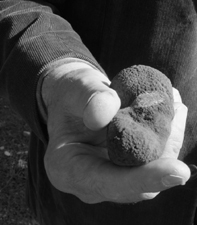
The author handles an edible black true truffle (Tuber) from Sardinia.
Edible black truffle. Photo © Jackie Fortey.
When the truffles were first recognized as fungi rather than some spontaneously generated freak of nature, it was thought that such curious productions comprised a single group of organisms – a reasonable assumption, one might think. They deserved one of Linnaeus’ high-level classification tags – an Order. But when microscopes came to be focussed on the tissues inside the truffle, where the spores were developing, an interesting discovery was made. Not all truffles were alike. Those that graced the tables of the rich and hedonistic showed features at the microscopic level like those of another gourmet treat, the morel (Morchella esculenta). In other, and more technical, words they were ascomycetes. These fungi bear their spores inside minute sacs or asci of the order of a tenth of a millimetre long – there are usually eight such spores, so the asci have a very typical microscopic appearance, rather like eggs wrapped in a sausage. However, some other truffles, for example a genus called Hysterangium, showed evidence that they were related instead to the gasteromycetes – the group of fungi that includes puffballs and stinkhorns. These are basidiomycetes, which carry their spores in an entirely different way from the ascomycetes; they are typically borne atop a special cell called a basidium, usually four spores in a loose cluster. The white mushrooms that fill vats in supermarkets are distantly related basidiomycetes, as are the majority of fungi that troop through the woods in autumn. The ascomycetes separated from the basidiomycetes very early in earth history, and certainly more than a billion years ago. It is preposterous to classify truffles together that have such different evolutionary origins – and so the ascus-bearing truffles were separated from the basidium-bearing truffles: so far, so sensible, and resulting in two Orders. For common names we now had ‘truffles’ and ‘false truffles’.
However, the story did not end there. From other microscopic hints there were suspicions that there were several origins for truffles in both the ascomycete group and the basidiomycete group. Truffles might have arisen repeatedly, on separate evolutionary trees, for all their superficial similarity. The closest relatives of a truffle might prove to be one of several different kinds of more normal-looking mushrooms and other fungi. The truffle shape, including its subterranean growth, is a specific adaptation – a mode of life, if you like. It was not so difficult to imagine a ‘truffle habit’ originating several times, because most fungi do indeed develop underground, and only later erupt at the surface. If development were somehow ‘arrested’ at the early stage – well, then you might have something like a truffle. The trouble is how could you pair the truffle with its closest-related mushroom, since there is so little general resemblance between them? This is where the molecular evidence should come into its own. The appropriate mushroom partner should, in principle, show more similar sequence patterns at the molecular level to its truffle relatives than it does to other truffles or indeed other mushrooms. So it has proved. Using the appropriate genomic tool, especially one known as ribosomal ITS (Internal Transcribed Spacer), the complexity of the origin of truffles has been demonstrated. It turns out that at least six different kinds of mushrooms – that is, the basidium-bearing kind – have become ‘truffleized’, to coin a term. To add to this there are several more origins of truffles of the ascus-bearing kind, of which the true truffle, Tuber, is one. Far from being a natural group of organisms, the truffles originated from numerous different fungi on several different occasions, and it all probably happened millions of years ago.
Why should anyone care about such apparently esoteric information? After all, most people can happily pass their lives without seeing a truffle of any kind, and who but an outstanding eccentric would spend hours carefully digging around in the litter under trees to find false truffles of the inedible kind? But then, who would guess that truffle evolution was crucial to the survival of several charming Australian marsupials? For the Australian group of truffles, including some placed in the genus Hydnangium, were also independently evolved in close association with Eucalyptus trees. These false truffles provide a prime foodstuff for bettongs and potoroos, which are delightful, nocturnal cat-sized animals that are now the focus of intensive conservation efforts. The more that is known of their requirements the more likely they are to survive in the twenty-first century. False truffles are as important to their continued existence as keeping them from the depredations of feral cats. So what might at first seem extraordinarily specialized information has links to those ‘pretty furry things’ after all; nature is seamless, its connections multifarious.
The truffle example also links back to where we started – the questions of taxonomy. Every time a truffle under examination turns out to be related to an entirely different mushroom, we can imagine a curator cursing quietly under his breath and moving the relevant preserved specimens to a different drawer. This is an extreme case of ‘revision’ – revisiting taxonomy. The point is that we expect classification systems, genera, families and so on in ascending order, to reflect fundamental resemblances between the species included in them. The species themselves are the units of this classification – at least they are if we have recognized them correctly – and they are the real things that get shifted around from one drawer to another. The genus or family whose name might be written on the drawer or cupboard is a theoretical concept, subject to change as science advances. As with the truffles, species may be added or taken away or moved around. The up-to-date taxonomist wants his classification concepts to square with modern views. For most such scientists this means that the species included in a genus, for example, should have descended from a common ancestor – that is, constitute what is known as a clade. The characters shared by the species in a genus – and nowadays these can be molecular characters as much as the traditional ‘hairs on legs’ – are what defines it, makes it a natural entity. Discover new characters and the concept of the genus may well change, and so will the species included within it. This results in changes in generic names for a given species that irritate many people, and particularly knowledgeable amateur scientists. ‘Why do they have to keep changing the names?’ is a common complaint. However, the contemporary investigator is obliged to seek out genera, or families, that are clades; the scientific method used in recognizing these groups is known as cladistics; and the whole business of examining relationships between organisms in this way is usually termed phylogenetic analysis, or simply phylogenetics. If names have to change as a result of careful reconsideration of species, well, that’s the price of progress. Much modern taxonomy is based upon computer analysis of relationships, where all the characters possessed by a group of organisms under study are allowed to fight it out until the ‘best’ arrangement of species is discovered, resulting in a diagram – a cladogram – showing how species relate to one another. The eventual classification is then drawn up directly from the cladogram. For example, several clades of species clustering together might be recognized as separate genera, and if these genera then cluster together in a more inclusive group this larger group might be the basis of a family.
This sounds technical, and so it is. Quite a few famous taxonomists are computer experts first, and lovers of organisms second. They think in algorithms rather than algae. They are mostly interested in animals and plants as experimental material for their classificatory computer programs. Their conversation tends to revolve around the statistical criteria for the support of one piece of the cladogram or another; an outsider hearing these people chatting might think she was overhearing an unknown Amazonian language. However, arcane though it might sound, the cladistic approach has made taxonomy much more of a science, and less dependent on the word of an authority alone. It provides a unifying method across the spectrum of organisms, from virus to vicuña, and can embrace all kinds of evidence, from the molecular to the anatomy of a blue whale. But it will be clear by now that it also makes problems for that Linnaean system of naming animals and plants. Linnaeus himself designed his ‘system of nature’ before the notion of evolution had gained currency. Some might have considered that the order of nature might be an expression of the mind of God alone: ‘he made them high and lowly, he ordered their estate’, as the hymn puts it. The idea that classification might involve notions of descent from a common ancestor was a subsequent introduction. The species as the unit of currency of classification was the only thing in common between these pre- and post-Darwinian worlds. And with the arrival of cladistics and molecular analysis the old Linnaean system might be seen to creak and groan under the stress of frequent changes in nomenclature – so much so that some scientists have tried to persuade their colleagues that the time has come to abandon the Linnaean binomial altogether. They want to replace it, or at least augment it, with something called the PhyloCode.
As this is written the PhyloCode is still undergoing its own evolution, and it might be premature to anticipate the outcome. Many critiques of the Linnaean system are surely correct. There is no consistency in the use of the ranks of the system between different kinds of organism; some parts of the natural world have small genera, other parts have large ones, and a family can be a very different concept from one worker to another. We already have an intuitive feel for this. Birds are finely divided into genera separated by tiny anatomical differences; on the other hand some genera of plants and fungi might include several hundred species. The attractive sea snail genus Conus includes at least six hundred species. The recognition of what makes a genus or family is partly a matter of tradition and taste. It is also undoubtedly true that there are not enough categories to recognize all the different levels of relatedness that a modern cladistic ‘phylogenetic tree’ can recognize, and nobody wants extra formal ranks with names like supersubfamilies or subsuperfamilies. There are quite enough names already.


